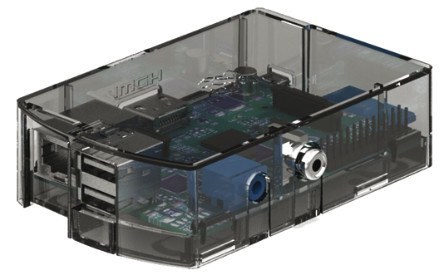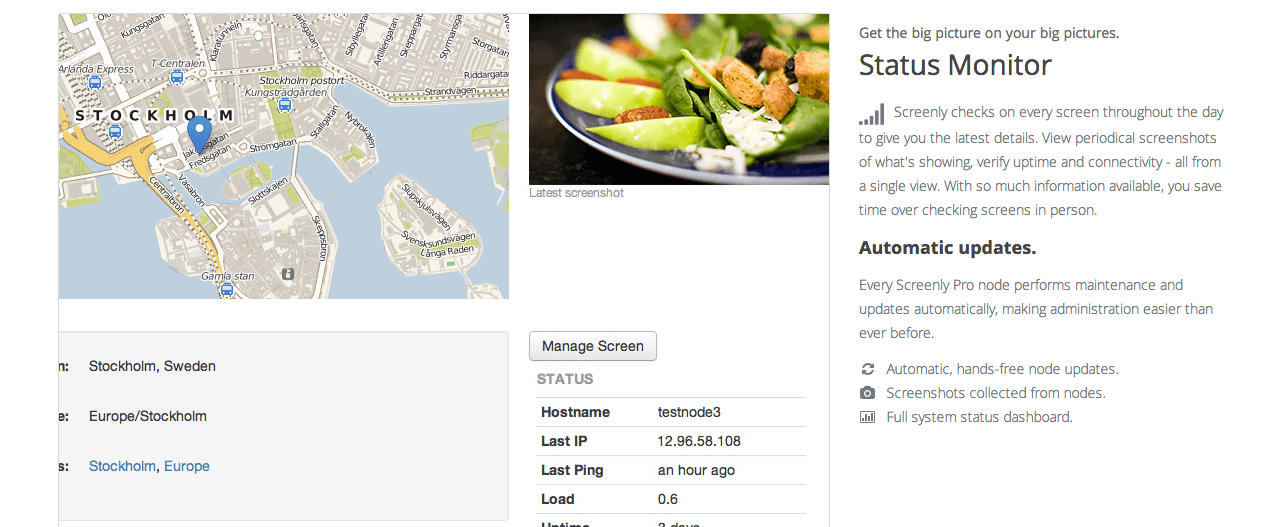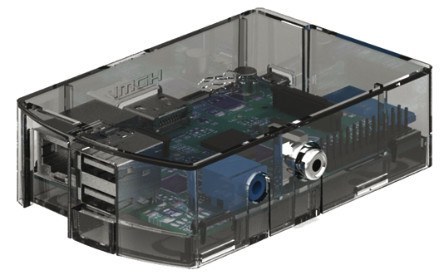
Screenly Serves Up Raspberry Pi As Alternative To Android Players
May 3, 2013 by Dave Haynes
The Raspberry Pi is now very close to being a viable digital signage playback device, and a for-profit software company has been investing the time and resources to develop a Linux-driven player and content management system to bring to the market.
![]() WireLoad – which has developers in the UK and Sweden – says its Screenly is free for open source developers and $10/month for a Pro version you don’t have to be a nerd to use. The tiny Raspberry Pi credit card-sized computers cost $35 at a base level, and once you deal with a memory card, HDMI cable, power adapter and a case you are at all of $60.
WireLoad – which has developers in the UK and Sweden – says its Screenly is free for open source developers and $10/month for a Pro version you don’t have to be a nerd to use. The tiny Raspberry Pi credit card-sized computers cost $35 at a base level, and once you deal with a memory card, HDMI cable, power adapter and a case you are at all of $60.
I traded emails with Viktor Petersson of WireLoad to find out more about the product.
Q – What was and is the big challenge to overcome in terms of getting this to work?
Creating a good user experience with the limited resources available on the Raspberry Pi. Screenly would have been a lot easier to write for regular desktop-class hardware. For the Pi we really had to optimize everything and try to utilize the hardware acceleration as much as possible. The good news is that since we know the exact hardware the software is going to run on, we are able to target the software very closely to the hardware and get “close to the metal.”
Without the vibrant Raspberry Pi community, creating Screenly Pro and OSE would have been a lot more difficult. In addition to great feedback, we’ve been able to leverage a lot of Open Source solutions for the Raspberry Pi, such as the OMXPlayer software for hardware accelerated video playback.
Q – Is there a tradeoff on performance and capabilities for that low cost?
There’s definitely a performance tradeoff, but given the price-point it’s an amazing device.
There are things that aren’t working as well as we’d like them to. This is particularly visible when we are showing web pages. Heavier pages with a lot of JavaScript and media tend to perform with some lag. However, if you just design the pages with the platform in mind, the performance is great.
We are working on improving this and hope to be able to leverage hardware acceleration in the near future.
Other than that, the Raspberry Pi is capable of displaying full 1080p videos and images beautifully.
Q – How will you market this?
So far, we haven’t had to do any traditional marketing, and if we are able to maintain this momentum, I doubt we will have to. Screenly OSE, the Open Source version of Screenly, has created a lot of interest in Screenly. Just to give you an idea, the Screenly OSE thread on the Raspberry Pi forum is one of the most popular forum threads on the entire forum. As a result, we see a lot of traffic coming from there.
We view Screenly OSE as both a great product for smaller installations, and a driver to Screenly Pro. A lot of users start out with Screenly OSE as a single installation. The natural step then is to upgrade to Screenly Pro when you roll out more nodes. Among many other things, Screenly Pro enables you to manage multiple nodes.
Q – What is the target market?
That’s not really something we’ve spent too much time thinking about yet. The traction we saw from Screenly OSE early on was so great that we simply decided to put it out there and see where it takes us.
The customers we’ve talked to have very different applications for Screenly. The applications range from single-node installations in a Mom-and-Pop shops to large retail chains and internal dashboards for offices. In addition to those, we’ve also been approached by few customers who are working on innovative display projects.
Geographically, the traction has also been very scattered, but most of the companies we’ve been in touch with thus far have been in Europe and North America.
Q – What does Wireload do and is this a US or Swedish thing, or both?
WireLoad is an ISV. We have a portfolio of software products and services that ranges from YippieMove (an email migration service with an impressive client list) to Blotter (a top-ranked Mac application) to a fair number of other smaller projects. Screenly is the latest addition to our portfolio.
The company is based in the US on paper, and a large set of our customers for our products prior to Screenly have been in the North American market. I’m currently working out of Sweden, and my co-founder (Alexander) is working out of London. In addition to myself and Alexander, our team members are scattered around the globe.
Q – Are there any supply chain issues getting Pis?
That used to be an issue early on, but I think they are able to keep up with the demand right now. The last few batches I’ve ordered have been delivered within a week or so, which I think is completely reasonable.
—————————————————-
The company, on its website, says it analyzed the digital sign market and noticed that most of the products fell into one of two buckets:
- Bloated and overpriced embedded solutions with decent functionality.
- Home-made solutions (that were often buggy and reliant on Adobe Flash).
What we wanted was an affordable, modern and lightweight solution, but there weren’t any around.
When the Raspberry Pi was announced, we had an ‘aha’ moment. This was what was needed to reinvent the industry. At only $35 it was accessible for everyone. Not only that, the hardware was powerful enough to support full-HD playback.
After spending a few months on the waitlist, we got our Rasperry Pi last summer and got busy cranking out a prototype. The result is a product that we call Screenly – a turn-key digital signage solution. All you need to manage it is your web-browser.

Screenly is available in two flavors: OSE and Pro.
Screenly OSE is Open Source. Anyone can install, modify and use it free of charge. This edition is available today. All you need to install Screenly OSE is a more or less a Raspberry Pi and a TV. The installation instructions can be found here. The limitation with Screenly OSE is that it was designed for a stand-alone setup. If all you need is to setup a single screen, Screenly OSE is the perfect fit for you. You can find an online demo here. The full source code for Screenly OSE is available on Github.
Screenly Pro on the other hand is a commercial solution. It was designed for users who want to manage multiple nodes (or screens). It runs on the same hardware as Screenly OSE, but it provides you with a central interface. Screenly Pro also provides you with other benefits such as system hardening, node alarm/health and more. Screenly Pro is currently in beta, but you can read more about it here.
Screenly OSE was developed for Raspbian, a Debian-derived Linux distribution for the Raspberry Pi. Screenly has been reported working on Arch too, but it is not supported.
Like all the Android players coming on the market, this is an ARM processor under the hood.
One small hangup is that users need a wired DHCP (dynamic) Internet connection, as wireless is not supported, at least not yet.
At $10/month and $60 hardware cost, the three-year capital and operating cost of this solution is $420, or better said, $11.67 per month. That does NOT factor in the unknown of how well these units will perform long term, and one field service call to replace or beat a unit back into operation will balloon costs.
However, the same can be said for the majority of the new Android ARM-based solutions out there. While costs are low, only time will reveal reliability levels.
Will a $60 “PC” and a $10/month SaaS service cause great market upheaval? Nope. The SaaS price is low, certainly, but you can buy fully commercial, field-proven digital signage SaaS subscriptions at that number. Or you could load Rise Vision, which touts an enterprise-grade platform for free (they make their money in other ways).
There are very, very, very few large accounts that will take a risk on such a new solution and buy in numbers. However, there are countless higher education, K-12, community organizations and small tech-savvy businesses that will take a hard look at this. I know from my own Web stats that Raspberry Pi serves a LOT of page views and has since I first started writing about it two years ago.
But … like the rise of Android, the evidently successful development and launch of a low-low cost device running Linux is another indication that the days of making margin off of $600-$1,000 PCs and developing to Windows are coming to a close.
I know from direction conversations the big players in this space are, for the most part, have low-cost ARM stuff on their test benches.





Leave a comment